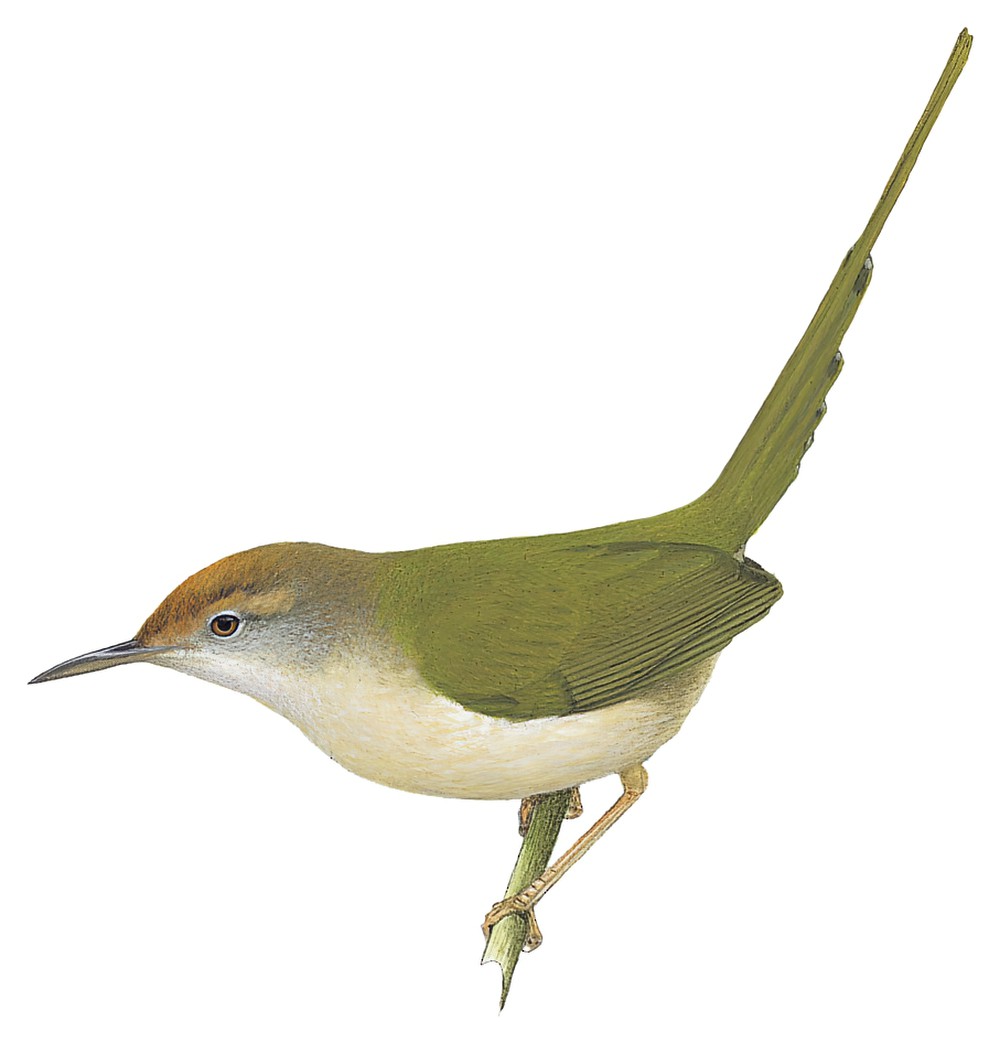Common Tailorbird / Orthotomus sutorius

Common Tailorbird
SCI Name:
Protonym: Motacilla sutoria Indn.Zool. p.7 pl.7
Taxonomy: Passeriformes / Cisticolidae / Orthotomus
Taxonomy Code: comtai1
Type Locality: by inference, Ceylon.
Author: Pennant
Publish Year: 1769
IUCN Status: Least Concern
DEFINITIONS
ORTHOTOMUS
(Cisticolidae; Ϯ Olive-backed Tailorbird O. sepium) Gr. ορθος orthos straight; τομευς tomeus, τομεως tomeōs knife, edge (cf. ορθοτομεω orthotomeō to cut straight); "Gen. 34. ORTHOTOMUS. Rostrum mediocre, rectum, subdepressum, basi triquetrum, attenuatum: culmine basi carinato, versus apicem leviter arcuato. Mandibula tomiis rectissimis. Nares basales, magnæ, superne membrana clausæ, inferne rima longitudinali apertæ. Alæ: remiges, 1 spuria, 2 et 3 abrupte longiores, 4—8 longiores subæquales externe emarginatæ, ceteræ gradatim breviores cuneatæ. Pedes subelongati. Digitus exterior a medio ad basin connexus: hallux validus. Ungues compressi arcuati acuti, postico medio duplo majore. Acropodia scutulata. The straightness and slenderness of the bill distinguish Orthotomus from the two former genera [Pomatorhinus, Prinia]; these characters, with the depression and triangular form of the base of the bill, prevent its union with the other genera of this family. I have not been able to determine satisfactorily the affinity of this genus. The slenderness of the bill and its other habits associate it with the Certhiadæ; in the acumen of the bill and the size of the hallux it resembles in some degree the genus Sitta. Spec. 1. Orthotomus sepium. ... Chiglet Javanis." (Horsfield 1821); "Orthotomus Horsfield, 1821, Trans. Linn. Soc. London, 13, p. 165. Type, by monotypy, Orthotomus sepium Horsfield." (Watson in Peters 1986, XI, 173).
Var. Orthotoma.
Synon. Edela, Sutoria.
sutoria / sutorius
L. sutorius of a shoemaker < sutor, sutoris cobbler < suere to stitch.
SUBSPECIES
Common Tailorbird (guzuratus)
SCI Name: Orthotomus sutorius guzuratus
guzurata / guzuratensis / guzuratta / guzurattica / guzuratus
Guzurat (= Gujarat = Gujerat), India.
Common Tailorbird (patia)
SCI Name: Orthotomus sutorius patia
patia
Nepalese name Pǎtia for the Common Tailorbird (subsp. Orthotomus sutorius).
Common Tailorbird (luteus)
SCI Name: Orthotomus sutorius luteus
luteus
L. luteus saffron-yellow < lutum saffron (cf. Late Med. L. luteus or lutea bird mentioned by Turner 1544, which he associated with the Yellowhammer).
● ex “Yellow-shouldered Parrot” of Latham 1781 (unident. ?Amazona sp?).
● ex “Perruche jaune de Cayenne” of d’Aubenton 1765-1781, pl. 525, and “Guarouba” of de Buffon 1770-1783 (syn. Guarouba guarouba).
● ex “Alia Xochitenacatl” of Nieremberg 1635, “An other sort of Xochitenacatl, Toucan or Brasilian Pye” of Willughby 1676, “Tucana lutea” of Brisson 1760, “Aracari à bec noir” of de Buffon 1770-1783, and “Black-billed Toucan” of Latham 1781 (unident.).
Common Tailorbird (sutorius)
SCI Name: Orthotomus sutorius sutorius
sutoria / sutorius
L. sutorius of a shoemaker < sutor, sutoris cobbler < suere to stitch.
Common Tailorbird (fernandonis)
SCI Name: Orthotomus sutorius fernandonis
fernandonis
E. C. Fernando (d. 1966) Singhalese collector, taxidermist at Colombo Mus., Ceylon (subsp. Orthotomus sutorius).
Common Tailorbird (inexpectatus)
SCI Name: Orthotomus sutorius inexpectatus
inexpecta / inexpectata / inexpectatum / inexpectatus / inexpectus / inexspectata / inexspectatus
L. inexspectatus unexpected, surprising, unlooked for < in- not; exspectatus awaited, expected < exspectare to await.
● “In view of the stability shown by Arremonops conirostris conirostris through a wide area, the appearance of this form so near the type-locality of that race is surprising and inexplicable” (Chapman 1914) (subsp. Arremonops conirostris).
● “It certainly was unexpected to find such a striking and hitherto unknown species on Guadalcanar, and this and the discovery of other new forms on the island shows that the ornithological exploration of Guadalcanar has hitherto been very imperfect” (Hartert 1929) (Guadalcanaria).
● “et necata inexpectatum nobis gaudium dedit novae speciei, ante nunquam visae” (Forster 1844) (Pterodroma).
● "Named both for the unexpected nature of its distribution, being restricted to two provinces of Ghana, and the fact that there are no obvious geographic barriers that separate it from two other members of the genus" (Voelker et al. 2016) (subsp. Stiphrornis erythrothorax).
● “On examining a large series of birdskins collected in the northern parts of Celebes and presented to the Leyden Museum by S. C. I. W. van Musschenbroek, Esq., I was quite astonished to find, that there exists in the Minahassa, beside Strix [= Tyto ] Rosenbergii, another large species of Barn-owl, very different as well from Strix Rosenbergii as from all the other known species” (Schlegel 1879) (Tyto).
Common Tailorbird (longicauda)
SCI Name: Orthotomus sutorius longicauda
longicauda
L. longus long; cauda tail.
● ex “Merle à longue queue du Sénégal” of d’Aubenton 1765-1781, pl. 220, and “Vert-doré” of de Buffon 1770-1785 (syn. Lamprotornis caudatus).
● ex “Petit Figuier à longue queue de la Chine” of Sonnerat 1776, and “Long-tailed Warbler” of Latham 1783 (subsp. Orthotomus sutorius).
● ex “Plumet-blanc” of Brisson 1760 (syn. Pithys albifrons).
● ex “Perruche de Malac” of d’Aubenton 1765-1781, pl. 887, “Grand Perruche à long brins” of de Buffon 1770-1785, and “Malacca Parrakeet” of Latham 1781 (Psittacula).
● ex “Merle Tricolor à Longue Queue” of Levaillant 1801-1804, pl. 114 (unident.).
Common Tailorbird (maculicollis)
SCI Name: Orthotomus sutorius maculicollis
maculicollis
L. macula spot; Mod. L. -collis -throated, -necked < L. collum neck.
Common Tailorbird (edela)
SCI Name: Orthotomus sutorius edela
edela
"ORTOTOME EDÈLE. ORTHOTOMA EDELA. TEMM. Planche 599, fig. 2 [Ortotome édèle]. M. Lesson a publié la figure et la description de cet oiseau Centurie zoologique, pl. 71, pag. 212, sous le nom de Edela Ruficeps, sans doute sans avoir pu se douter que le genre avait déjà été établi par M. Horsfield, et que l'espèce eût plusieurs congénères, même au nombre de six, dont cinq qui ont plus ou moins de roux à la tête." (Temminck 1836) (subsp. Orthotomus sutorius).
UPPERCASE: current genus
Uppercase first letter: generic synonym
● and ● See: generic homonyms
lowercase: species and subspecies
●: early names, variants, mispellings
‡: extinct
†: type species
Gr.: ancient Greek
L.: Latin
<: derived from
syn: synonym of
/: separates historical and modern geographic names
ex: based on
TL: type locality
OD: original diagnosis (genus) or original description (species)












